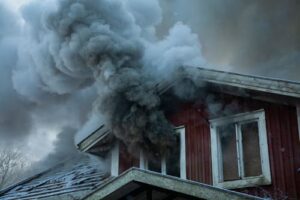How to file a wildfire insurance claim
You should file a claim for wildfire damage to your home as soon as possible. Wildfires cause widespread damage, and insurance companies will have a lot to deal with; get your claim in fast. The steps to a wildfire claim are outlined below.
- Make the call to the claims number right away. An insurance professional will guide you through the process.
- An insurance adjuster will visit your home when it’s safe to do so. The adjuster will assess the damage and ask for “proof of loss.” This will most likely be a form to fill out along with backup documents you have collected– pictures, receipts, serial numbers of appliances, etc.
- Get repair quotes. Find a reputable contractor to give you estimates for the work. Sometimes the insurance company has a list of approved companies they work with, other times you can choose one yourself.
- Meet all deadlines. Work with the adjuster and provide all the paperwork they ask for in a timely manner. There will be a series of deadlines each step of the way and you want to be on top of it. The time limits can vary carrier to carrier and state to state.
Immediate actions after wildfire damage
Wildfires move fast, and in some cases you may be evacuated and unable to return home until the danger is past. Safety is paramount.
“First, you should ensure the safety of you and your loved ones,” says Matt Banaszynski, CEO of the Independent Insurance Agents of Wisconsin. “Then you should do whatever you can do to prevent further damage to your home.”
However, if authorities say it’s not safe, don’t return home, even to protect your home and belongings. Wait until you are cleared to return.
“Document the damage by taking videos and photos to provide to the insurance company. Then call your insurance agent and ask for help in filing a claim with the insurance company. Next, call a remediation company or contractor so they can get to work to repair and prevent damage,” Banaszynski says.
If there is water damage from the fire department’s efforts to control the fire, you'll want to deal with that as well.
“Mold is a major concern for any water damage incident,” he says.
If you have made any initial repairs yourself, keep receipts.
“It is important to document what you have already done and how much time you have spent, some insurers will compensate you for your time and related expenses,” Banaszynski says.
Doing any more repairs without the help of licensed contractors at this point is probably not a good idea, though.
“Unless the claimant is an experienced tradesman, construction manager, builder, general handyman or in some other manner experienced with hands-on residential construction, I do not personally recommend that a claimant undertake the repair or replacement of covered property. Building codes and ordinance, construction plans, tradesman scheduling, etc are not easily accomplished (if at all) if one isn't fully versed in the norms of the residential construction industry,” says Gordon Adams, former Risk Management Society (RIMS) board member, and long-time California insurance professional.
He cautions that if repairs are not done right or cause more damage, it only delays the claims process.
If you’re unable to live in your home because of severe damage or have been evacuated by authorities, your homeowners policy covers temporary housing expenses. Check with your carrier ahead of time to see if they have a list of covered hotels, temporary housing and any additional expenses. Keep receipts for your hotel stay, meals and other related expenses.
Filing a claim
Once you’re ready to file a claim, gather all your pictures, video and receipts and submit them to the insurance company. Marc Ragin, Associate Professor of Insurance and Risk Management at University of Georgia says do this right away: “As soon as possible once you’re sure that…damages are significant enough that they will exceed your deductible,” he says.
“There’s no such thing as “too much” documentation in these situations,” he says.
Damage to your home’s structure is covered by the dwelling coverage section of your policy. Damage to fences, sheds and detached garages is handled by the other structures portion of your insurance. Damage to the belongings inside your house, like furniture, artwork, etc. is covered under the personal property section of your home insurance.
Repairing your property
Repairs may be slow to begin, as wildfires cause a lot of damage and there may be many claims. Be patient as you move towards repairing the damage, and follow these steps:
- Check with your insurance company before contacting contractors. While you can generally choose your own contractor, most insurance companies have a list of preferred providers who will guarantee their work.
- Find a reputable contractor that is licensed and bonded. Choose a contractor that has all the proper licenses and insurance and comes highly recommended by friends and family.
- Get repair quotes and send them to your insurance company. Save all quotes, estimates and receipts. You can also submit any repair work receipts you did on your own.
- You’ll get a check to pay deposits to the contractors and start the work. For the structural work of your home, your insurance company pays out the replacement cost settlements in two phases. First, you will get a check for the depreciated value.
- Once the work is finished and inspected and up to code, you’ll get another check to pay off the repair bill. This will be for the actual replacement cost that won’t be known for sure until it’s done.
Homeowners insurance and wildfire evacuation
If you must evacuate, your homeowners insurance provides some coverage for temporary housing. This is called loss of use coverage or additional living expenses (ALE). This also covers you when you can’t live at home during repairs.
“Generally if such a need arises due to a covered event the insurance carrier will provide guidance on places to stay or a daily benefit amount available for housing, meals allowances, personal expense allowances, transportation and similar needs," Adams says. So always check with your carrier ahead of time to see what’s an allowable expense and what isn’t.
Sometimes time limits apply, as well as dollar amounts, so be aware.
“Living expense (extra expense) coverage only lasts for so long, and any delays associated with repairs could cause the living expense benefit to run out prior to the residence being repaired enough for habitation. Should this happen the claimant would then be on the hook for any non-covered living expenses. This could, of course, be very expensive,” Adams says.
Keep all receipts to be reimbursed by the insurance company.
How long does a wildfire insurance claim take?
Wildfire insurance claims may have different timelines depending where you are and how many other people were affected. If a large swath of people also experienced damage, there will be many claims all at once.
Most insurance companies do their best to get checks out for temporary living expenses sooner than later. For homes that require extensive repairs, you may be looking at several checks over a period of months as the contractors do their work. Ask your carrier if they can send an advance while you’re waiting for your claim to be paid, if there are delays.
Check with your carrier and state insurance board regarding any state laws governing claim payment timelines.





